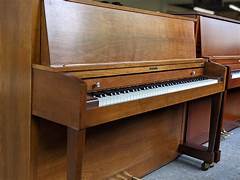Upright Piano Options for Schools, Studios, and Everyday Practice

Walk into any music classroom or rehearsal studio in 2025 and there’s a good chance you’ll find an upright piano anchoring the room. Even with the rise of digital keyboards and software instruments, educators still lean on the tactile feedback, acoustic tone, and sheer reliability of a well-built upright. Models built for institutions, think the Yamaha P22 Upright, are designed to handle countless hours of lessons and rehearsals without falling out of tune or falling apart. And when it’s time to choose, many programs consult trusted local dealers such as Music Exchange to compare options, service plans, and long‑term costs. Here’s why uprights remain the workhorse choice for schools, studios, and everyday practice.
Why schools and studios continue to rely on upright pianos
Space, budget, and durability drive most institutional decisions, but the story doesn’t end there. Upright pianos deliver the acoustic benefits teachers need, real hammers, strings, and a resonating soundboard, without consuming precious floor area or the full cost of a baby grand.
They also create better habits. Students learn to control weight, listen for color, and develop pedaling finesse by interacting with physical strings. That tactile loop, finger to key to hammer to string, is hard to simulate. Teachers notice it in the tone students produce and in how quickly they internalize touch.
Then there’s reliability under heavy use. Institutional uprights are built with hardwood back posts, robust pinblocks, stable plates, and cabinet reinforcements that keep the structure tight through seasonal changes and constant playing. In practice rooms where doors open and close all day, that stability matters as much as tone.
Total cost of ownership is another quiet win. A quality upright can serve a program for decades with routine tunings and occasional regulation or hammer work. When amortized across hundreds of student-hours per term, the per‑use cost is tough to beat. And unlike many electronics, a well-kept upright retains real resale value should a department upgrade later.
Finally, the format is simply practical. Uprights sit comfortably against a wall, leave room for conductor sightlines, and don’t dominate rehearsal layouts. They’re the right-size instrument for the job.
Design features that support frequent use and reliability
Institutional uprights earn their reputation in the details. A few construction choices make a massive difference when a piano will see thousands of hours each year:
- Structural backbone: Multiple hardwood back posts and a thick spruce soundboard add strength and tonal projection. The plate and rim components are designed to hold tension steadily so the piano stays in tune longer between service visits.
- Pinblock and tuning stability: Laminated maple pinblocks grip the tuning pins securely. In busy environments with varying humidity, this is the first line of defense against pitch drift.
- Action built to last: Sturdy action parts, durable key bushings, and long-wearing hammer felt keep the touch consistent. Technicians can regulate the action repeatedly without chasing premature wear.
- Mobility with control: Reinforced toe blocks and double casters make it possible to move the piano safely between rooms. Locking front casters (when equipped) and a heavy-duty dolly add stability during rehearsals.
- Classroom-safe cabinetry: Locking fallboards and top lids protect keys and internal components. Satin finishes hide scuffs, and long music desks accommodate multiple scores.
- Service-friendly access: Uprights made for institutions open quickly for tuning and regulation. Standardized parts and clear action geometry help technicians keep them performing at a high level.
A model like the Yamaha P22 Upright is a good example of these choices in practice. At about 45 inches tall, it’s compact yet resonant, with a solid spruce soundboard, a robust institutional cabinet, locking key cover, and practical casters for school use. The middle pedal is often configured as a practice/mute feature, handy in dorm-adjacent practice rooms, while the long music desk and durable keytops suit everyday teaching. There are other strong contenders in the same class, but the P22 has been a benchmark for decades because it balances build quality, serviceability, and price in a way programs understand.
How upright models serve both practice and performance
A good upright has two jobs on campus: train hands and ears day in, day out, and then show up credibly for small performances. When action geometry is properly regulated, students can practice repetition, control, voicing, and pedaling on an upright and transfer those skills to grands without relearning touch. It won’t mimic a concert grand’s repetition speed or bass length, but it gets surprisingly close on core technique.
For performance, taller uprights (around 45–52 inches) project well in studio recitals, masterclasses, and chamber coaching sessions. They fit in classrooms where audiences sit close, and they record nicely in tight rooms, engineers often place a pair of small-diaphragm condensers just above the action to capture clarity while using a room mic for bloom.
Uprights also excel in teacher–student setups. The pianist can face the class, speak naturally, and demonstrate without rearranging the room. With a practice/mute pedal or an add‑on silent system, the same instrument becomes a late-night practice partner without disturbing neighboring rooms.
The net result: one upright covers the daily grind and the occasional spotlight, especially in programs that don’t have space, or budget, for multiple grands.
Upright pianos in classrooms and rehearsal spaces
Choir rooms, theater rehearsal halls, and band suites ask a lot of a piano. The instrument must start on pitch, cut through ensemble sound when needed, and survive constant movement, all while keeping students safe.
Placement matters. Against an interior wall, away from HVAC blasts, helps tuning stability. A cover reduces dust and sun fade. In choral rehearsals, many directors angle the upright slightly so the conductor maintains eye contact while accompanying: that little tweak improves communication without sacrificing tone.
Mobility protocols matter too. Use a proper piano dolly when moving between rooms, avoid thresholds that can twist casters, and assign responsibility for locking the fallboard and top after each block. A small log sheet taped discreetly inside the bench keeps everyone accountable for covers, locks, and caster brakes.
Four quick tips programs rely on:
- Schedule two tunings per term plus a regulation touch‑up after heavy usage (musicals, juries, festival prep).
- Keep a hygrometer near the piano and aim for roughly 40–50% RH: consider a humidity control system if swings are large.
- Stock spare keytops and bench hardware, little fixes prevent downtime.
- Protect the music desk with a removable strip when using pencil‑heavy scores.
When it’s time to source or rotate inventory, many schools work with regional partners like Music Exchange to coordinate delivery, ongoing service, and trade‑up paths. Having one point of contact simplifies budgeting and keeps instruments consistent across rooms.








